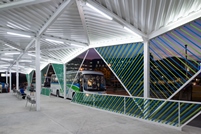
PHILLIPINES Brooklyn, USA-based architecture and design firm, CAZA (Carlos Arnaiz Architects), with offices in Bogota, Colombia; Lima, Peru; and Manila, Philippines, has unveiled its latest public works project, a Bus Rapid Transit (BRT) station design for Cebu, Philippines. The public transit system is the first to be developed in the city, which has a population of roughly 3.5 million people. It will serve 15 – 25% of those and as of May 2016, five of the 19 stations along the route have been built and are operational.
The modular type bus station designed by CAZA has been inspired by the ancient basket weaving traditions of Cebu. As part of the project, the firm was tasked with not only building an interconnected system of bus stations, but designing the landscaping and street furniture around each one. While they vary in size each station has a standardised system of furniture that includes such items as planters and benches. Consistency in design was integral part of the project.
The Cebu BRT project will also significantly improve pavements, pedestrian crossings, and street lighting, while also addressing some serious problems, such as damaging street flooding. Each section of station roof acts as a water catcher, and is able to direct the rainfall from intense rainstorms away from the street. At the same time, the roof also acts as a source of shade, shielding people from the intense heat and extreme weather that is characteristic of certain times of year in the Philippines. While this project will significantly improve the public transit system, it’s hoped that the infrastructure will also become a cultural icon for Cebu.
Carlos Arnaiz, Principal of CAZA said: “The Cebu BRT is really the first transit system of its kind in the Philippines that services an entire metropolitan area connecting a historic district with the international airport and fast-growing regions on the periphery. The project marks a landmark for a country struggling to figure out how to improve the lives of its citizens and resolve transportation challenges with limited resources.”


